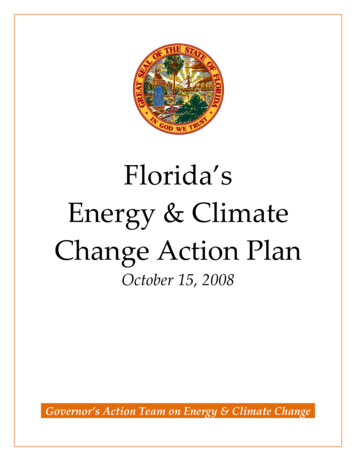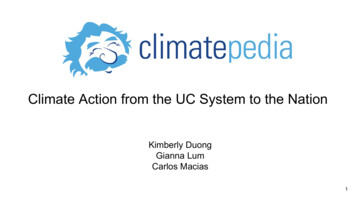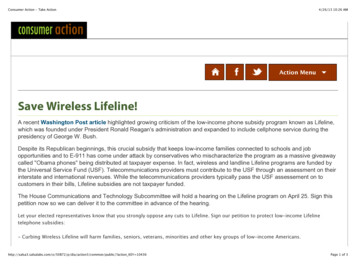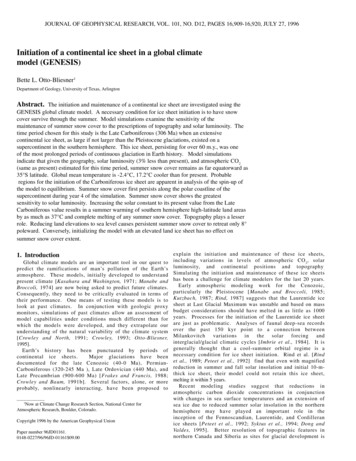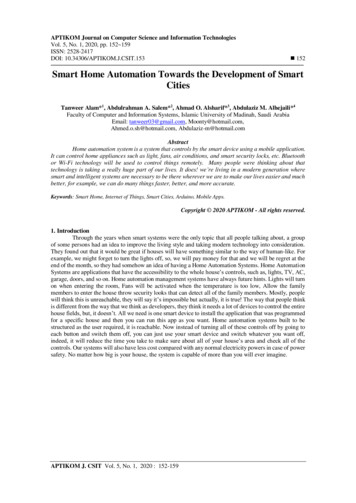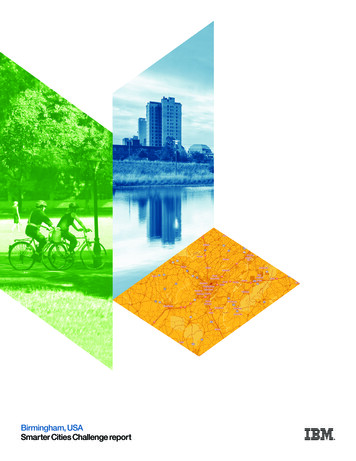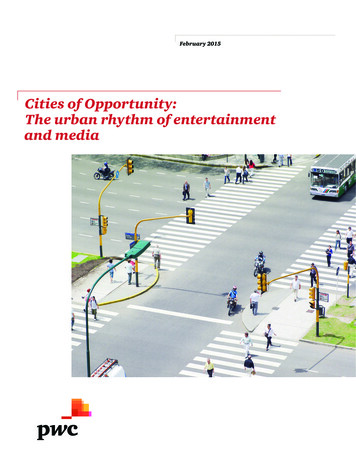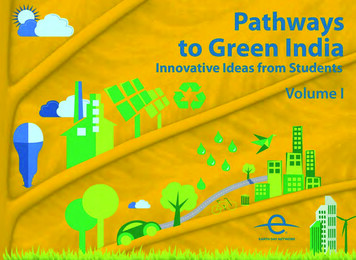
Transcription
Global climate action from cities,regions, and businessesImpact of individual actors and cooperative initiatives onglobal and national emissions. 2019 edition.Technical annex II: Methodology for quantifying thepotential impact of international cooperativeinitiatives and assessing links between nationalclimate initiatives and sustainable development goals(SDGs)Suggested citation:NewClimate Institute, Data-Driven Lab, PBL Netherlands Environmental Assessment Agency, GermanDevelopment Institute/Deutsches Institut für Entwicklungspolitik (DIE), Blavatnik School of Government,University of Oxford. Global climate action from cities, regions and businesses: Impact of individualactors and cooperative initiatives on global and national emissions. 2019 edition. Technical annex II.Download the reporthttp://newclimate.org/publications/
Table of contentsTable of contents . iiList of abbreviations . iii1 Introduction . 12 Selection of initiatives . 43 Quantification of potential GHG emissions reduction impact by international cooperative initiatives 63.1Energy Efficiency . 63.2Buildings . 83.3Transport . 93.4Renewable Energy (RE) . 123.5Industry and Business . 163.6Forestry. 183.7Non-CO2 GHGs . 193.8Cities and Regions . 214 Quantification of overlaps between ICIs . 264.1 Approach. 264.2 Results . 285 Links between international climate initiatives and SDGs . 295.1SDG Climate Action Nexus Tool (SCAN-tool) . 295.2Explicit links between international climate initiatives and SDGs . 31References . 32Glossary. 35ii
List of abbreviationsACIAirport Carbon AccreditationAREIAfrican Renewable Energy InitiativeASEANAssociation of South East Asian NationsATAGAir Transport Action GroupA2030Architecture 2030 initiativebcmbillion cubic metersC40Cities Climate Leadership GroupCATClimate Action TrackerCCACClimate and Clean Air CoalitionCCATWCollaborative Climate Action Across the Air TransportWorldCOP-2121st Conference of the PartiesCORSIACarbon Offsetting and Reduction Scheme forInternational AviationCPSCurrent Policies Scenario from the IEA World EnergyOutlookCSAMCentral South AmericaCSPConcentrated Solar PowerDOEU.S. Department of EnergyEPAU.S Environmental Protection AgencyETIPEuropean Technology & Innovation PlatformETPIEA’s Energy Technology PerspectivesEWIEuropean Wind InitiativeFAOFood and Agriculture Organization of the UnitedNationsGCFTFGovernors’ Climate and Forests Task ForceGCoMGlobal Covenant of MayorsGFEIGlobal Fuel Economy InitiativeGGAGlobal Geothermal AllianceGHGGreenhouse gasGPFLRGlobal Partnership of Forest Landscape RestorationGWGigawattGWPGlobal Warming ational Civil Aviation OrganizationICCTInternational Council on Clean TransportICIInternational Climate Cooperative InitiativeIEAInternational Energy AgencyIIASAInternational Institute for Applied Systems Analysisiii
(I)NDC(Intended) Nationally Determined ContributionsIPCCIntergovernmental Panel on Climate ChangeIRENAInternational Renewable Energy AgencyITFInternational Transport Forum of the OECDlgelitres of gasoline equivalentLULUCFLand-use, land-use change and forestryMEPSMinimum Energy Performance StandardMhaMega hectare (ha x 106)MtCO2eMegatons of CO2 equivalentMWhMegawatt hoursNEPADNew Partnership for Africa’s DevelopmentNGONon-governmental organisationNOAAU.S.NationalAdministrationNPSNew Policies Scenario from the IEA World EnergyOutlookNYDFNew York Declaration on ForestsOECDOrganization forDevelopmentPVPhotovoltaicRERenewable EnergyRoWRest of WorldSARIPCC’s Second assessment ReportSDSSustainable Development Scenario from the IEAWorld Energy OutlookSEADSuper-efficientEquipmentDeployment InitiativeSBTScience-based target initiativeSEIISolar Europe Industry InitiativeSLCPShort-lived climate pollutantSSIU.S. SunShot InitiativeTWhTerawatt hoursUNUnited NationsUNGCUnited Nations Global CompactU4EUnited for Efficiency InitiativeUNFCCCUnited Nations Framework Convention on ClimateChangeWEOWorld Energy OutlookWMOWorld Meteorological OrganizationWRIWorld Resources InstituteWWFWorld Wildlife dApplianceiv
1 IntroductionThis document provides a detailed overview of the methodology used to quantify the potential impact ofinternational cooperative initiatives (ICIs) on national and global greenhouse gas (GHG) emissions,including: The process and criteria for selecting initiatives to include in this study;The methodology used in:o calculating the Function-Output-Fit (FOF) analysis;o quantifying the emission reduction potential of selected initiatives;o accounting for overlaps between different initiatives;o tools used to establish links, as well as potential synergies and trade-offs, between ICIsand Sustainable Development Goals (SDGs).We first selected initiatives to quantify and analyse their potential impact on GHG emissions in the eightdifferent thematic areas they operate in, such as forestry, buildings, and transport, using the initiative’starget. We identified and removed overlaps from actors with targets in more than one initiative; forinstance, when a city or region had made an emission reduction commitment through several initiatives,only the most ambitious goal was factored into the calculation, to avoid counting the same commitmentseveral times.We then distributed the emission reduction impacts of these selected initiatives to ten high-emittingeconomies: Brazil, Canada, China, the European Union (EU), India, Indonesia, Japan, Mexico, SouthAfrica and the United States of America (US), as well as to “Rest-of-the-World” (RoW). We also identifiedinitiatives with goals that could span many sectors and thus overlap with other initiatives targeting thesame emissions source, for instance where a transport and air pollution initiative both target caremission standards or where initiatives that focus on promoting wind and solar energy both replaceemissions from fossil fuel electricity generation. We accounted for overlaps between each initiative withthe likely overlap they have with other initiative efforts. For more detail on our overlap calculations,please see Section 0.Once all overlaps were accounted for, we aggregated the emission reductions that could be collectivelyachieved through the ICI activity in the ten high-emitting economies and RoW into a global total (Figure1).Figure 1. An illustration of the steps of the analysisThe ICIs quantified in this report were categorized into eight sectors: energy efficiency, buildings,transport, renewable energy (RE), industry and business, forestry, non-CO2 GHGs, and cities andregions. Because the current national policies scenario projections based on Kuramochi et al. (2018) donot provide sub-sector level energy consumption projections, we used energy demand and supplyprojections from other sources including IEA World Energy Outlook (WEO) 2018 as well as IEA EnergyTechnology Perspectives (ETP) 2016 as proxies to calculate the ICIs’ impact on energy demand andsupply and CO2 emissions. Table 1 lists all sources of proxy energy demand and supply projectionsused.In the current analysis, the base year was determined by the most recent year for which data is availableand the time horizon is 2030. Historical GHG emissions data is used up to 2016. The modelling baseyear for (sub)sector-level baseline scenarios ranged between 2013 and 2016, depending on the initiative1
and data availability. All GHG emission values are expressed using the global warming potential (GWP)values from the Fourth Assessment Report (AR4) of the Intergovernmental Panel on Climate Change(IPCC, 2007; Klein and al, 2007) to ensure consistency with our baseline scenarios.Table 1: (Sub)sector-level baseline energy demand and supply projections against which the impact ofinternational cooperative initiatives (ICIs) was calculated.Actionarea/ sectorEnergyEfficiencyBuildingsTransportCurrent national policies scenarioIEA World Energy (WEO) 2018 (IEA, 2018)Current Policies Scenario (CPS); 2016 asbase year.IEA WEO 2018 (CPS).GFEI: current policies scenario projectionsfrom TIMER model provided to Kuramochiet al. (2018).CAATW: ICAO (2016).RenewableEnergyIndustry &BusinessForestryNon-CO2GHGsIEA WEO 2018 (CPS) with exceptionsdescribed below: AREI: Continental renewable capacityand generation projections for 2030 aretaken from IEA WEO 2018 SustainableDevelopment Scenario (SDS) instead ofthe CPS. GGA: For geothermal heating, baseyear (2014) values were taken fromLund and Boyd (2015), future businessas-usual projections of 2020 were takengeothermalheatcapacityfromprojections from the IEA GeothermalRoadmap (IEA, 2011b), and 2030projections were extrapolated from2020 numbers using WEO 2018 CPSgrowth rates.RE100: IEA WEO 2018 (CPS).SBTi: IEA ETP 2016 (IEA, 2016a) (6 Cscenario: 6DS); 2013 as base year.Forsell et al. (2016) reference scenarioadjusted by current policies scenarioprojections by Kuramochi et al. (2018) forten high-emitting economies; 2015 as baseyear.CCAC (CH4 and HFC emissions): CH4 emissions: EPA database (USEPA, 2012) are used for historicalnumbers and future projections, whilecountry-specific emissions use EDGAR(EU JRC and PBL, 2014); 2015 as baseyear. HFCemissions:Thehistoricalemissions dataset up to 2013 wasdevelopedusingthePRIMAP(Gütschow et al., 2017) and EDGAR(EU JRC and PBL, 2014) databases,and future growth rates are based onNationally determined contributionscenarioIEA WEO 2018 New Policies Scenario(NPS); 2016 as base year.IEA WEO 2018 (NPS).GFEI: NDC scenario projections fromTIMER model provided to Kuramochi etal. (2018).CAATW: Same as CPS (as emissionsfrom international air travel are notincluded in NDCs).IEA WEO 2018 (NPS).RE100: IEA WEO 2018 (NPS)SBTi: IEA ETP 2016 (4 C scenario:4DS); 2013 as base year.Forsell et al. (NDC scenario); 2015 asbase year.CCAC (CH4 and HFC emissions): CH4 emissions: NDC scenariois proxied using the emissionsprojectionsunderEPAdatabase (U.S. EPA, 2012)and the % reduction inprojectedCO2emissionsbetween CPS and NPS fromIEA WEO 2018. HFC emissions: The historicalemissions dataset up to 2013was developed using thePRIMAP (Gütschow et al.,2
Cities &Regionsthe reference scenario reported in U.S.EPA (2012).2017) and EDGAR (EU JRCand PBL, 2014) databases,and future growth rates arebased on the referencescenario reported in U.S. EPA(2012).Current national policies scenarios for allcity and region actors follow nationalprojections from Kuramochi et al. (2018).Unconditional NDC scenarios for all cityand region actors follow nationalprojections from Kuramochi et al.(2018).3
2 Selection of initiativesAs a first step, we identified an initial list of over 300 international cooperative initiatives (ICIs) thatsupport national, subnational and non-state action, drawn from the Climate Initiatives Platform andsupplemented by our own research. We narrowed the list to 54 based on whether initiatives: refer to transnational climate mitigation,have a potentially significant impact on GHG emissions,are transparent in their operations.In consultation with experts in non-state and subnational action, we further refined the list based onwhether the initiatives had a quantifiable target to calculate emissions reductions. Lastly, the listnarrowed down to 17 ICIs based on whether the initiatives had realistic actionable and implementablemitigation plans and whether they passed a Function-Output-Fit (FOF) analysis, which assesses theinitiatives’ likelihood of implementation, indicated by recent progress, reporting, and other regularupdates. The methodology for the FOF analysis can be found in (Chan et al., 2018). Furthermore, ifvarious initiatives cover the same topic area with high degrees of overlap, we choose the one with themost ambitious target and scope. Table 2 summarises the order and steps taken to select our final listof initiatives, while Table 3 displays the final selection of ICIs.Table 2: Selection process of international cooperative initiatives (ICIs)Selection steps1. Full list of identified ICIs2. ICIs with links to mitigation3. ICIs with potentially significant impact on transnationalemissions reduction4. ICIs with quantifiable targets5. ICIs passing Function-Output-Fit analysis, with realisticactionable mitigation plansNumber ofshortlist300 26354ICIsin3017Table 3: Final list of selected ICIs for quantificationInternational cooperativeinitiativeUnited for Efficiency (U4E)Super-efficient Equipment andAppliance Deployment (SEAD)Architecture 2030Collaborative Climate ActionAcross the Air Transport World(CAATW)Lean and GreenGlobal Fuel Economy Initiative(GFEI)European Technology &Innovation Platform Phtovoltaic(ETIP-PV)Africa Renewable EnergyInitiativeGlobal Geothermal Alliance(GGA)RE100 initiativeScience Based Targetsinitiative (SBTi)Regions coveredSector/themeGlobal (developingcountries)GlobalEnergy alTransportTransportEuropeRenewable energyAfricaRenewable energyGlobalRenewable energyGlobalGlobalBusiness and industryBusiness and industryEnergy efficiency4
[Deforestation] Bonn Challenge/ New York Declaration onForests[Restoration] Governors’Climate and Forests Task Force(GCFTF) / New York Declarationon ForestsClimate and Clean Air Coalition(HFCs and methane)Under2 CoalitionGlobal Covenant of Mayors forClimate and EnergyC40 Cities Climate LeadershipGroup (C40)GlobalForestryGlobalForestryGlobalNon-CO2 GHGsGlobalGlobalCities and regionsCities and regionsGlobalCities and regions5
3 Quantification of potential GHG emissions reductionimpact by international cooperative initiatives3.1Energy Efficiency3.1.1 Super-Efficient Equipment & Appliance Deployment Initiative3.1.1.1DescriptionThe Super-efficient Equipment and Appliance Deployment (SEAD) Initiative is a voluntary collaborationamong governments working to promote the manufacture, purchase, and use of energy-efficientappliances, lighting, and equipment worldwide. SEAD is an initiative under the Clean Energy Ministerial(CEM) and a task of the International Partnership for Energy Efficiency Cooperation (IPEEC). SEADconsists of 18 participating governments (mostly in advanced economies) collaborating on theimplementation of appliance energy efficiency policies. If all SEAD governments were to adopt currentpolicy best practices for product energy efficiency standards, 2000 TWh of electricity consumption(roughly twice the annual consumption in Japan) could be saved annually by 2030. 1 Letschert et al.(2012) estimated that realizing the SEAD Initiative’s goal will save consumers more than US 1 trillionbetween 2010 and 2030.3.1.1.2QuantificationThe energy savings potential of SEAD is quantified based on an assessment for the period between2015 and 2025 conducted for OECD and non-OECD countries conducted by the Lawrence BerkeleyNational Laboratory (LBNL) and presented in IEA (2015). For “Current national policies plus initiatives’goals” scenario, we assumed that the energy consumption reduction rates below the current nationalpolicies scenario projections in 2030 in the SEAD member countries as of 2015 (Australia, Brazil,Canada, the European Union, India, Indonesia, Japan, Korea, Mexico, Russia, South Africa and theUnited States) equal the energy consumption reduction rates below the reference 6 C scenario (6DS)for 2025 as calculated in IEA Energy Technology Perspectives 2016 (IEA, 2016a).Since the Current national policies scenario projections based on Kuramochi et al. (2018) do not providesector-specific energy consumption projections, we used the Current Policies Scenario (CPS)projections from IEA WEO 2018 as a proxy to calculate the energy consumption levels for the buildingsand industry sectors in 2030 under the SEAD on a country level. For China, which became a SEADmember after 2015, we assumed that the energy savings potential relative to the SEAD membercountries as of 2015 would be identical to the potential assessment results from Letschert et al. (V. E.Letschert et al., 2012). We did not consider the potential impact in other new SEAD member countries(Argentina, Chile and Saudi Arabia) due to the relatively small size of energy consumption compared toother member countries. The calculated energy consumption levels under the SEAD as described abovewere then compared to the New Policies Scenario (NPS) projections of IEA WEO 2018 to estimate theenergy savings potential under the “NDCs plus initiatives’ goals” scenario compared to the NDCscenario.CO2 emissions reduction potential was calculated by multiplying the energy savings potential calculatedabove by electricity CO2 emission factors from fossil fuel-fired power generation derived from the IEAWEO 2018 projections (CPS for “Current policies plus initiatives’ goals” scenario and NPS for “NDCsplus initiatives’ coals” scenario). The upper end estimate assumes replacement of coal-fired powergeneration and the lower end estimate assumes replacement of gas-fired power generation. ForCanada, we used the IEA WEO 2018 US emission factors; for Indonesia we use the IEA WEO s-the-SEAD-Initiative6
ASEAN-average emission factors; for Mexico we used values from the IEA Mexico Energy Outlook (IEA,2016b).3.1.2 United for Efficiency (U4E)3.1.2.1DescriptionU4E is a global initiative supporting developing countries and emerging economies to move theirmarkets to energy-efficient appliances and equipment.U4E builds on the success of the en.lighten initiative, which accelerates the transition to efficient lightingworldwide. It broadens the scope to six high-efficiency product categories (five for which data isprovided), such as commercial, industrial and outdoor lighting, residential refrigerators, room airconditione
ACI Airport Carbon Accreditation AREI African Renewable Energy Initiative . Architecture 2030 initiative bcm billion cubic meters C40 Cities Climate Leadership Group CAT Climate Action Tracker CCAC Climate and Clean Air Coalition CCATW Collaborative Climate Action Across the Air Transport . Governors’
